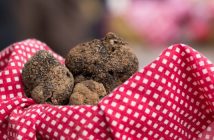Karen Yates goes green for 72 hours in Western Sweden and discovers just how switched on the Swedes are when it comes to sustainability…
I first visited the Bohuslän region of Western Sweden a few years ago for another publication, and part of that trip was a lobster safari. This time we joined a seaweed safari, which speaks volumes about how, finally, the world is waking up to the need for sustainability and for all of us to eat more plant-based food. One of the countries at the helm of this positive change is Sweden.
We’ve driven from Gothenburg (more of this later) for two hours in the latest, swankiest hybrid Volvo (of course) to the Tjurpannan nature reserve on the Bohuslän coast to meet Jonas Pettersson, who runs Catxalot (pronounced ‘catch-a-lot’) seaweed safaris with his wife Linnéa Sjögren. After changing into his diving gear and disappearing underwater with a knife, Jonas emerged with a selection of seaweed for us to sample.

He explained that seaweed is sustainable because provided you cut it above the root the plant grows back and can be harvested again in about 10 days. According to Jonas, the reason oily fish, such as salmon, is so rich in healthy omega-3 fatty acids is that the salmon eat smaller fish that feed off seaweed, and it’s the seaweed that contains the omega-3 (Swedish company Simris, uses seaweed to make vegan omega-3 capsules, cutting out the fish entirely).
Like vegetables, each type of seaweed has its own flavour and uses. For instance, rörhinna (gutweed, or mermaid’s necklace), is now used in most restaurants in Sweden and is very quickly deep-fried for a taste of white truffles, while dulse tastes something like bacon and can be used in ice cream to make one that tastes both savoury and sweet, a bit like salted caramel. Take it from me that its umami flavour is addictive.

From the nearby seaside village of Havstenssund, Jonas and his wife run a little shop selling everything from dried seaweed, dulse ice cream (Catxalot’s is called Dulse de Leche), facial oils and creams, as well as organising safaris, walks and kayak tours, and running cookery courses, showing how to make the seaweed soup, crackers and biscuits we had for lunch, plus plenty more.
Back into the Volvo for a 40-minute drive to Strömstad to catch the ferry to South Koster island. The ferry goes round the islands in a circle and takes an hour there but just 20 minutes to sail back; before you board call into nearby Backlunds café, bar and restaurant for cakes, loaves and great vegetarian rolls – everything is baked on the premises using sustainable organic ingredients.
After an hour’s scenic sailing, we arrived at car-free South Koster island, Sweden’s most westerly inhabited island (next stop Scotland), part of the Kosterhavet marine national park and home to the country’s largest seal colony. At just 3km by 5km, it’s easy to cycle around the island, which we did with local Stefan von Bothmer, who shared his enthusiasm for sustainability and organic produce, inviting us to pick whatever we liked from his massive greenhouse before going to Kosters Trädgårdar, the organic garden, restaurant and farm shop he runs with his wife Helena.

Baker Antonia patiently showed us how to make sourdough pizzas topped with incredible local cheeses and the organic produce we’d just picked and poured us natural wines and beers, created with no added sulphates. Cycling back with no lights to guide us, everyone sighed at the site of a pollution-free inky sky, stars glittering like diamonds, the plough and milky way clearly visible. Fortunately for us after the natural wines, which seemed more potent than their ABV suggested, you can stay on the island; Kostergården has simply furnished cabins with sea views.
The following morning, after the ferry back to Strömstad and a half-hour drive inland to Gråstorp in Västergötland in what looks to me like Wallander country (although that is, in fact, much further south in Skåne), with its wide, flat landscapes, big skies and remote red-painted, wood-clad farmhouses, to meet Amanda Hellberg and Eveline Johnsson, aka Våra Oköttsliga Lustar (‘our non-carnal desires’, meaning vegetarian food).

Amanda and Eveline have created four vegetarian cookery books, which hopefully will be translated into English soon. The lunch they served for us included roasted organic root vegetables, salads, excellent local cheeses, seeded bread, whipped butter and a fabulous chocolate cake, all enjoyed with the freshly pressed juice we made ourselves from apples in the orchard.
Next stop, just half an hour away on the Källandsö peninsula with views over Vänern lake (Sweden’s largest), is the 18th-century baroque Läckö Slott (‘slott’ means castle), visitor centre (the first naturum in Sweden where you can stay), restaurant and Lilla Slottsrägården (little castle garden), which supplies the restaurant with vegetables and fruit and is the domain of head gardener Simon Irvine. After studying at Oxford and working at Kew, Simon came to Sweden in the 1980s and never left. He’s vegan and so is the garden, including the compost, about which he is passionate.

Simon adds nothing, not even horse manure, to his compost, just the faded flowers and leaves from the garden and organic vegetable scraps from the kitchen. Indeed, we could, and did, all learn a lot from softly spoken Simon, who explained his principles of sustainability as he showed us around the organic garden with its abundance of cabbages, kale, chard, cardoons, yellow beans, beetroot the size of a child’s head, squash, broccoli, potatoes, leeks, garlic, and herbs including intensely flavoured fresh green coriander seeds, punchy wild rocket and lemony sorrel, some of which we harvested for our supper.
Whatever is picked from the castle gardens inspires what Katrin Ljungblom and Stefan Söderholm prepare and serve at Hvita Hjorten (white deer), their restaurant in the visitor centre. Sharing plate after sharing plate of organic, sustainable, flavourful vegetarian food was served at our table, all cooked as Stefan decided there and then. You can also order local fish and meat.

Everything was delicious, especially the simply cooked, fresh-from-the ground potatoes in their skins with plenty of melted brown butter, plus a pudding of homemade vanilla ice cream with cardamom biscuits and rosehip syrup, also made with ingredients from the prolific garden. Course after course was enjoyed with Tender and True natural beer, made locally with, and named after, a variety of parsnips in the garden, plus a natural pinot noir. You could certainly taste the terroir, a word the Swedish, like us, have adopted from the French as their own.
The following morning, on our way back to Gothenburg, we stopped for fika (tea or coffee, which the Swedes make very strong, and cake), something that all generations have Swedes have enjoyed for decades, at Lasse Larsson’s sustainable organic bakery Nolbygårds from an old farmhouse in Alingsås, now a shabby chic café with upcycled furniture and an art gallery, where local artists show their work but Lasse takes no commission. Indeed, he used to be an art student with a passion for baking and soon realised making a living as an artist would be harder than being a baker. He’s passionate about trains, too, and there’s a 1950s driver’s cab and carriage in the garden with a sign encouraging children to play on it.

As for the fabulous bakes on offer, Lasse told us that the Swedish favourite cardamom bun is a big seller, then there is a winning apple and cinnamon kanel, wienerbröd (Danish pastry), Portuguese pastel de natal and plenty more, all fresh from the oven. As well as running his sustainable bakery, Lasse contributes to the local community by taking in people who have suffered breakdowns or burnt out and helps to get them back on the feet by helping in their garden or kitchen. One man, he told us, was so burnt out he stared at the floor for a whole day. Soon he started to help out in the bakery and has now changed career to run his own sustainable organic bakery. Organic, sustainable and truly giving back – what a delicious way to live.
Back in Gothenburg, there is plenty of choice for sustainable living. From my room on the sixth floor of the Clarion Post Hotel, once the city’s main post office and next to Central Station, I could see the roof gardens that grow the salads, vegetables, chillies, wasabi, sorrel, mint, and more used in the hotel’s restaurants Norda, and vRÄ, the sustainable, organic sushi restaurant. The gardens are run by William Bailey and Jonas Lindh, who also run one of Europe’s largest urban farms, Kajodlingen, on a dock in the harbour at Lindholmen, supplying local restaurants and offering a weekly pick-and-pay in the warmer months.

Back near the hotel, da Matteo serves seriously good sustainable coffee, which is bought in fresh from countries including Columbia, Brazil, Kenya and Ethiopia, depending on the season, before the green beans are roasted in the café. I particularly liked the Columbian coffee – perfect with the ubiquitous cardamom bun.
Finally, sustainable choices for dining are plenteous, but we jumped on a tram to ice-cool Folk vegetarian bar and restaurant, in the foyer of Folkeatern, which is also a cinema. An ebullient waitress talked us through the menu and suggested plenty of sharing dishes for us, including padrones with chilli and sesame to start; buffalo mozzarella with courgettes, chilli, passion fruit and chives; wax beans with goats’ cheese; and pasta with ricotta and parmesan. Again, the natural wines served with the food seemed surprisingly potent – you have been warned.
Indeed, everyone we met in Western Sweden was enthusiastic about the need for sustainability and growing your own organic food. Let’s just hope the rest of the world catches up soon…
Photos by Tina Stafren




